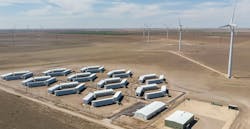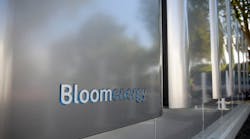Soluna Computing: Innovating Renewable Computing for Sustainable Data Centers
This month Soluna Computing has made significant steps towards delivering their vision sustainable, scalable, green computing data centers in Texas.
At the beginning of the month the company announced that they had signed a term sheet for their Project Hedy, a 120 megawatt (MW) data center collocated with a 200 MW wind farm.
With a plan to develop the project in two 60 MW phases, the company looks to leverage excess energy production while operating the data centers behind the meter.
John Belizaire, CEO of Soluna Holdings, Inc., commented:
This is another step forward in proving that flexible, large-scale computing can help renewable energy assets reach their full potential. We are excited to partner with and leverage the exceptional wind resources of Cameron County to power sustainable AI and Bitcoin mining at scale. In an environment where there is an ever-growing need for sustainable energy to power AI, we are one of the few companies using an innovative approach to unlock this precious resource.
A Classic Approach: Make a Problem an Opportunity
At its core, Soluna operates on a somewhat unique proposition: convert wasted renewable energy into scalable computing capacity.
With global data demands skyrocketing due to artificial intelligence, Bitcoin mining, and other compute-intensive applications, and with renewable energy often curtailed due to grid constraints, Soluna believes that the company sits at the intersection of necessity and innovation. The core innovation behind Soluna's operations is a concept they call Renewable Computing.
Traditional renewable energy plants, particularly wind and solar farms, frequently overproduce electricity that the grid can't absorb. This excess, or curtailed energy, is effectively wasted.
Soluna's model repurposes this energy by co-locating data centers directly at renewable power plants. This behind-the-meter strategy allows them to tap into low-cost power, avoid long grid interconnection delays, and reduce emissions.
Unlike conventional data centers tied to centralized grids, Soluna's modular facilities offer grid services while supporting batchable computing tasks like AI model training and Bitcoin mining.
This structure bypasses transmission limitations and offers rapid deployment, a crucial advantage in today’s computing-hungry world.
As of early 2025, Soluna has 478 MW of computing capacity either operational, under construction, or in development. Their long-term pipeline now exceeds 2.6 GW across 19 U.S. states, with a growing focus on AI and high-performance computing (HPC).
Key operational and in-progress projects include:
Dorothy 1A & 1B (Texas): These twin 25 MW facilities are powered by wind and serve Bitcoin hosting and mining workloads. Together, they consumed over 112,000 MWh of curtailed energy in 2024, demonstrating the impact of Soluna’s model.
Dorothy 2 (Texas): Currently under construction and scheduled for energization in Q4 2025, this 48 MW site will increase Soluna's hosting and mining capacity by 64%.
Sophie (Kentucky): A 25 MW grid- and hydro-powered hosting center with a strong cost profile and consistent output.
Project Grace (Texas): A 2 MW AI pilot project in development, part of Soluna's transition into HPC and machine learning.
Project Kati (Texas): With 166 MW split between Bitcoin and AI hosting, this project recently exited the Electric Reliability Council of Texas, Inc. planning phase and is expected to energize between 2025 and 2027.
Project Rosa (Texas): A 187 MW flagship project co-located with wind assets, aimed at both Bitcoin and AI workloads. Land and power agreements were secured by the company in early 2025.
These developments are part of the company’s broader effort to tackle both energy waste and infrastructure bottlenecks. Soluna's behind-the-meter design enables flexibility to draw from the grid or directly from renewable sources, maximizing energy value while minimizing emissions.
Competition is Fierce and a Narrower Focus Better Serves the Business
In 2024, Soluna tested the waters of providing AI services via a GPU-as-a-Service through a partnership with HPE, branded as Project Ada. The pilot aimed to rent out cloud GPUs for AI developers and LLM training.
However, due to oversupply in the GPU market, delayed product rollouts (like NVIDIA's H200), and poor demand economics, Soluna terminated the contract in March 2025.
The cancellation of the contract with HPE frees up resources for Soluna to focus on what it believes the company does best: designing and operating AI/HPC infrastructure from the ground up.
The company believes its co-located model gives it a unique advantage in supporting the compute demands of large AI models like GPT-4 and beyond.
Soluna’s Vision: Greener, Smarter, Faster
Soluna Computing isn’t just building data centers; it is creating a sustainable, scalable solution to two systemic issues: renewable energy waste and data center emissions.
According to RESurety analysis, Soluna’s data centers emit 75% less carbon than traditional ATC centers and enable the injection of clean energy into the grid, displacing fossil fuel generation.
Looking forward the company believes that if Soluna scales to 1 GW of AI-ready data centers, it could displace nearly 48 million metric tons of CO₂, equivalent to removing 11 million cars from the road over the life of those assets.
This energy efficient, sustainable future is made possible through Soluna’s unique execution model:
- Source curtailed energy from independent power producers.
- Build, own, and operate modular data centers.
- Provide hosting services to Bitcoin and AI customers.
- Offer ancillary services to grid operators.
The model is supported by Soluna’s proprietary MaestroOS™ software, which manages power flows, workload optimization, and grid interactions in real time.
Soluna enters 2025 with momentum, a cleaner balance sheet, and a sharp strategic focus. The key goals for the year include:
- Energizing Dorothy 2 by Q4 2025.
- Advancing Project Kati and Rosa to full financing and development.
- Expanding AI/HPC partnerships.
- Increasing demand response and grid service revenue.
As both renewable power generation and global compute needs grow exponentially, Soluna sits in a potential position to bridge the gap. Their infrastructure doesn’t just consume power, it monetizes waste, stabilizes grids, and accelerates the adoption of clean energy.
Soluna believes its unique value proposition, aligning the needs of renewable energy producers with the insatiable demands of data infrastructure, they can redefine what it means to build a data center in the future.
About the Author



